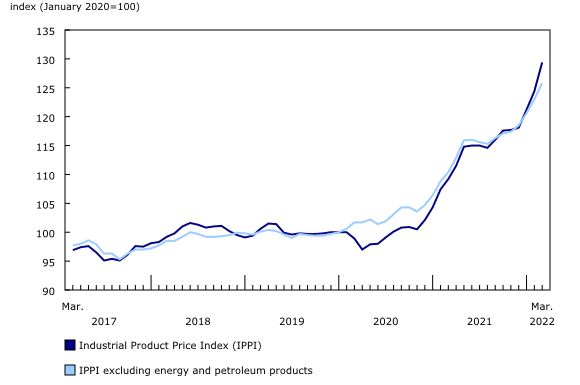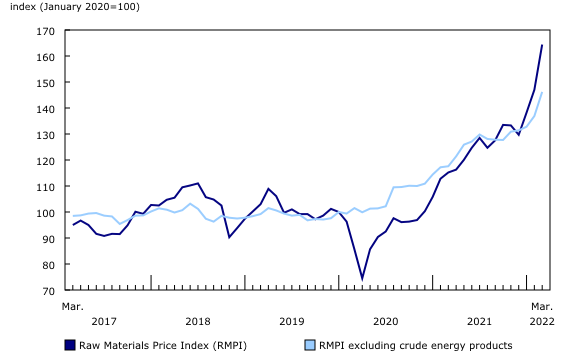Industrial product and raw materials price indexes, March 2022
Released: 2022-04-22
The Industrial Product Price Index (IPPI) rose 4.0% month over month in March 2022, the largest monthly change on record since the series began in 1956. Year over year, the IPPI increased 18.5%, its biggest gain since December 1974. Prices of raw materials purchased by manufacturers operating in Canada, as measured by the Raw Materials Price Index (RMPI), were up 11.8% on a monthly basis in March 2022 and up 42.7% year over year. The Russian invasion of Ukraine had effects on the prices of many commodities in March 2022.
Industrial Product Price Index
The IPPI rose 4.0% month over month in March. This was the largest monthly gain since the series began in January 1956. This monthly growth was mainly driven by higher prices for refined petroleum products. Year over year, the IPPI rose 18.5%, the biggest gain since December 1974 (+19.7%).
Prices for refined petroleum energy products (including liquid biofuels) rose 18.8%. This was the largest month-over-month increase on record for that series since it began in January 2010. Year over year, prices were up 65.7%. The increase in this group was mostly due to higher prices for diesel fuel (+23.3%) and motor gasoline (+14.9%). Higher prices for refined petroleum energy products were mainly driven by oil supply uncertainty caused by the Russian invasion of Ukraine. IPPI excluding energy and petroleum products was up 2.3%.
Prices for several metal products also increased in March. The primary non-ferrous metal products group was up 9.2%. This group includes unwrought gold, silver, and platinum group metals and their alloys (+5.5%), as well as unwrought aluminum and aluminum alloys (+8.3%). The primary ferrous metal products group rose 4.1%, mainly driven by hot-rolled iron or steel products (+7.6%). Concerns about the Russian invasion of Ukraine and ongoing inflationary phenomena both played a part in the price increases for safe-haven metals such as gold and silver. Aluminum prices were influenced by a multitude of factors: tight global supply, the effects of the Russian invasion of Ukraine and uncertainty regarding the COVID-19 pandemic in China. Russia, which accounted for about 6% of global aluminum production in 2021, lost one of its key suppliers of raw materials, as Australia banned exports of alumina and aluminum ores to Russia.
Softwood lumber rose 8.0% in March, posting a sixth consecutive monthly increase. Compared with the same month in 2021, prices were up 21.9%. Higher prices for softwood lumber were partially related to strong demand, as well as supply issues related to transportation.
PPrices for intermediate food products (+3.3%) and animal feed (+5.1%) both increased in March. These price increases are related to higher prices for crop products.
Ammonia and chemical fertilizers were up 7.8% in March, after posting a 0.5% decline in February. Compared with the same month in 2021, fertilizer prices increased 85.5%. High global prices for natural gas, a key input in fertilizers, played a part in this increase. Markets also responded to the effects of the Russian invasion of Ukraine. According to Bloomberg Green Markets, Russia accounted for about one-fifth of global fertilizer exports in 2021.
Raw Materials Price Index
In March, the RMPI was up 11.8% month over month and up 42.7% from March 2021, driven mainly by higher prices for conventional crude oil. Excluding crude energy products, the RMPI rose 6.8% monthly.
Prices for conventional crude oil were up 20.2% in March, which posted its largest monthly gain since June 2020 (+28.0%). Year over year, conventional crude oil prices rose 80.0%. Prices for synthetic crude oil (+22.6%) also increased in March. Market uncertainty due to the Russian invasion of Ukraine was a major factor in the price increases observed for crude oil.
Prices for crop products were up 14.0% month over month and were up 47.3% compared with the same month in 2021. Within this group, prices for canola were up 29.5% on a monthly basis and 69.4% year over year, partly due to low domestic supply. Wheat also posted month-over-month (+12.8%) and year-over-year (+63.8%) price increases. Both Russia and Ukraine are among the world's top four exporters of wheat.
Prices for metal ores, concentrates and scrap (+6.2%) posted their third consecutive monthly gain. Higher prices for waste and scrap of metal (+12.1%), as well as gold, silver, and platinum group metal ores and concentrates (+4.5%) were mainly responsible for the monthly increase in this group.
Note to readers
The Industrial Product Price Index (IPPI) and the Raw Materials Price Index (RMPI) are available at the Canada level only. Selected commodity groups within the IPPI are also available by region.
With each release, data for the previous six months may have been revised. The indexes are not seasonally adjusted.
The IPPI reflects the prices that producers in Canada receive as goods leave the plant gate. The IPPI does not reflect what the consumer pays. Unlike the Consumer Price Index, the IPPI excludes indirect taxes and all costs that occur between the time a good leaves the plant and the time the final user takes possession of the good. This includes transportation, wholesale and retail costs.
Canadian producers export many goods. They often indicate their prices in foreign currencies, especially in US dollars, and these prices are then converted into Canadian dollars. This is particularly the case for motor vehicles, pulp and paper products, and wood products. Therefore, fluctuations in the value of the Canadian dollar against its US counterpart affect the IPPI. However, the conversion to Canadian dollars reflects only how respondents provide their prices. This is not a measure that takes into account the full effect of exchange rates.
The conversion of prices received in US dollars is based on the average monthly exchange rate established by the Bank of Canada and available in Table 33-10-0163-01 (series v111666275). Monthly and annual variations in the exchange rate, as described in the release, are calculated according to the indirect quotation of the exchange rate (for example, CAN$1 = US$X).
The RMPI reflects the prices paid by Canadian manufacturers for key raw materials. Many of those prices are set on the world market. However, as few prices are denominated in foreign currencies, their conversion into Canadian dollars has only a minor effect on the calculation of the RMPI.
Products
The product "Industrial Product Price Index: 2021 Annual Review" is now available. This document is a review of how producer prices, as measured by the IPPI, changed in 2021 compared with 2020. The year 2021 faced a multitude of factors influencing prices, many of which stemmed from the COVID-19 pandemic. Economies reopened slowly as lockdowns were lifted and vaccinations became available, driving up demand.
Statistics Canada launched the Producer Price Indexes Portal as part of a suite of portals for prices and price indexes. This webpage provides Canadians with a single point of access to a variety of statistics and measures related to producer prices.
The video "Producer price indexes" is available on the Statistics Canada Training Institute webpage. It provides an introduction to Statistics Canada's producer price indexes—what they are, how they are made, and what they are used for.
Addition of a new table and additional data
Effective February 28, 2022, table 18-10-0272-01 has been added to the Statistics Canada website featuring regional indexes for select refined petroleum products. In addition, tables 18-10-0266-01 and 18-10-0268-01 now contain data for select 6- and 7-digit North American Product Classification System series.
Next release
The industrial product and raw materials price indexes for April will be released on May 19.
Contact information
For more information, or to enquire about the concepts, methods or data quality of this release, contact us (toll-free 1-800-263-1136; 514-283-8300; infostats@statcan.gc.ca) or Media Relations (statcan.mediahotline-ligneinfomedias.statcan@statcan.gc.ca).
- Date modified:



